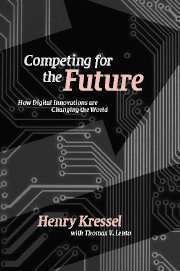Book contents
- Frontmatter
- Contents
- List of figures
- List of tables
- Acknowledgements
- Introduction
- Part I The technology – how electronic devices work – digital systems and software
- Part II Innovators, entrepreneurs, and venture capitalists
- Part III Global reach, global repercussions
- Appendix 1.1 Smaller, faster, more efficient MOSFETs
- Appendix 1.2 Building multi-transistor logic gates
- Appendix 1.3 MOSFETs in memory devices
- Appendix 1.4 CMOS reduces logic gate power dissipation
- Appendix 1.5 Laser diode basics
- Appendix 1.6 Light-emitting diodes (LEDs)
- Appendix 1.7 Photodetectors
- Appendix 1.8 Making fiber optic cables
- Appendix 1.9 Principles of LCD displays
- Appendix 2.1 The demise of analog computers
- Appendix 2.2 IP, TCP, and the Internet
- Appendix 2.3 Building an object-oriented program
- Index
Appendix 1.1 - Smaller, faster, more efficient MOSFETs
Published online by Cambridge University Press: 07 December 2009
- Frontmatter
- Contents
- List of figures
- List of tables
- Acknowledgements
- Introduction
- Part I The technology – how electronic devices work – digital systems and software
- Part II Innovators, entrepreneurs, and venture capitalists
- Part III Global reach, global repercussions
- Appendix 1.1 Smaller, faster, more efficient MOSFETs
- Appendix 1.2 Building multi-transistor logic gates
- Appendix 1.3 MOSFETs in memory devices
- Appendix 1.4 CMOS reduces logic gate power dissipation
- Appendix 1.5 Laser diode basics
- Appendix 1.6 Light-emitting diodes (LEDs)
- Appendix 1.7 Photodetectors
- Appendix 1.8 Making fiber optic cables
- Appendix 1.9 Principles of LCD displays
- Appendix 2.1 The demise of analog computers
- Appendix 2.2 IP, TCP, and the Internet
- Appendix 2.3 Building an object-oriented program
- Index
Summary
Bipolar beginnings
The bipolar transistor was the first important commercial device of the 1950s. Figure A-1.1.1 is a schematic of an n-p-n bipolar transistor. It consists of two p-n junctions back to back. The two n-type regions, called the collector and the emitter, are separated by a very thin p-type semiconductor layer, referred to as the base.
This structure is the successor to the original point-contact transistor invented at Bell Labs. The p-n junctions make it far more robust and practical than that first pioneering device.
We can get an appreciation of the bipolar transistor's principles of operation by applying a negative voltage to the n-type top side (emitter region) and a positive voltage to the n-type bottom side of the structure (collector region), where we see a resistor in series with the battery.
Because of the negative (forward) bias on the emitter-to-base p-n junction, electrons are injected into the base region. Since the base is very thin (a fraction of a micron), the injected electrons traverse it with little loss. They are collected by the reverse-biased base-to-collector p-n junction.
The result is that a large current flows through the collector circuit with the large resistor. On the other hand, the current through the other circuit (the emitter-to-base circuit) is very small, because few electrons flow through that circuit. In effect we have built an amplifier, in which a small current in the emitter-to-base circuit is translated into a large current in the collector-to-base circuit.
- Type
- Chapter
- Information
- Competing for the FutureHow Digital Innovations are Changing the World, pp. 347 - 354Publisher: Cambridge University PressPrint publication year: 2007



